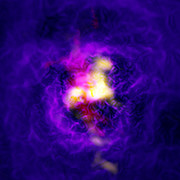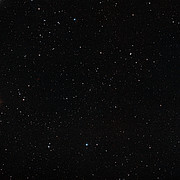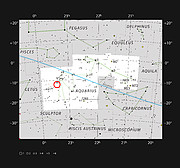Komunikat prasowy
ALMA i MUSE znalazły galaktyczną fontannę
6 listopada 2018

Obserwacje przy pomocy ALMA oraz dane ze spektrografu MUSE na teleskopie VLT ujawniły gigantyczną fontannę gazu molekularnego zasilaną przez czarną dziurę znajdującą się w najjaśniejszej galaktyce gromady Abell 2597 – pełen galaktyczny cykl przepływu do wewnątrz i na zewnątrz, który zasila kosmiczną fontannę, nigdy wcześniej nie był obserwowany w jednym systemie.
Jeden miliard lat świetlnych od nas położona się pobliska gromada galaktyk Abell 2597, w której znajduje się olbrzymia galaktyczna fontanna. Zaobserwowano, iż masywna czarna dziura w sercu odległej galaktyki pompuje ogromny strumień gazu molekularnego w przestrzeń kosmiczną, a następnie opada on z powrotem na czarną dziurę niczym wewnątrzgalaktyczna ulewa. Tego typu wielka kosmiczna fontanna, zawierająca przepływy w jedną i drugą stronę, nigdy wcześniej nie była obserwowana. Zaczyna się w wewnętrznych 100 000 lat świetlnych najjaśniejszej galaktyki w gromadzie Abell 2597.
„To prawdopodobnie pierwszy system, w którym znaleźliśmy wyraźny dowód na przepływ zimnego gazu molekularnego zarówno w kierunku czarnej dziury jak i wypływ na zewnątrz z dżetów, które generuje czarna dziura” wyjaśnił Grant Tremblay z Harvard-Smithsonian Center for Astrophysics, były stażysta w ESO, który kierował badaniami. „Supermasywna czarna dziura w centrum tej gigantycznej galaktyki działa jak mechaniczna pompa w fontannie.”
Tremblay i jego zespół użyli ALMA do śledzenie pozycji i ruchu cząsteczek tlenku węgla w mgławicy. Okazało się, że te zimne molekuły o temperaturze minus 50–260°C spadają na czarną dziurę. Badacze wykorzystali także dane z instrumentu MUSE na Bardzo Dużym Teleskopie (VLT) do śledzenia cieplejszego gazu — który jest wystrzeliwany przez czarną dziurę na zewnątrz w formie dżetów.
„Unikalnym apektem jest tutaj bardzo dokładna analiza źródła przy użyciu danych zarówno z ALMA, jak i MUSE” wyjaśnił Tremblay. „Oba urządzenia tworzą razem niesamowicie potężną kombinację.”
Oba te zestawy danych razem dają kompletny obraz procesu: zimny gaz spada na czarną dziurę wzbudzając jej aktywność i powodując wystrzeliwanie szybkich dżetów plazmy w przestrzeń. Dżety te wypływają z okolic czarnej dziury w formie spektakularnej galaktycznej fontanny. Będąc bez szans na ucieczkę z uścisków grawitacji galaktyki, plazma ochładza się, zwalnia i ostatecznie opada z powrotem na czarną dziurę, gdzie cykl zaczyna się na nowo.
Te bezprecedensowe obserwacje mogą rzucić nowe światło na cykl życia galaktyk. Naukowcy spekulują, że proces ten może być nie tylko powszechny, ale także kluczowy do zrozumienia formowania się galaktyk. O ile spadek i wypływ zimnego gazu molekularnego były wcześniej wykrywane, to po raz pierwszy oba zostały wykryte jednocześnie w jednym systemie, jest to więc pierwszy dowód na to, że oba stanowią elementy tego samego gigantycznego procesu.
Gromada Abell 2597 widoczna w gwiazdobiorze Wodnika. Jej nazwa pochodzi od katalogu bogatych gromad galaktyk (Abell). Katalog zawiera także gromady takie, jak Fornax, Hercules, czy Pandora.
Więcej informacji
Wyniki badań opublikowano w artykule pt. “A Galaxy-Scale Fountain of Cold Molecular Gas Pumped by a Black Hole”, który ukaże się w “The Astrophysical Journal”.
Skład zespołu badawczego: G. R. Tremblay (Harvard-Smithsonian Center for Astrophysics, Cambridge, USA; Yale Center for Astronomy and Astrophysics, Yale University, New Haven, USA), F. Combes (LERMA, Observatoire de Paris, Sorbonne University, Paris, France), J. B. R. Oonk (ASTRON, Dwingeloo, Holandia; Leiden Observatory, Holandia), H. R. Russell (Institute of Astronomy, Cambridge University, Wielka Brytania), M. A. McDonald (Kavli Institute for Astrophysics and Space Research, Massachusetts Institute of Technology, Cambridge, USA), M. Gaspari (Department of Astrophysical Sciences, Princeton University, USA), B. Husemann (Max-Planck-Institut für Astronomie, Heidelberg, Germany), P. E. J. Nulsen (Harvard-Smithsonian Center for Astrophysics, Cambridge, USA; ICRAR, University of Western Australia, Crawley, Australia), B. R. McNamara (Physics & Astronomy Department, Waterloo University, Kanada), S. L. Hamer (CRAL, Observatoire de Lyon, Université Lyon, France), C. P. O’Dea (Department of Physics & Astronomy, University of Manitoba, Winnipeg, Kanada; School of Physics & Astronomy, Rochester Institute of Technology, USA), S. A. Baum (School of Physics & Astronomy, Rochester Institute of Technology, USA; Faculty of Science, University of Manitoba, Winnipeg, Kanada), T. A. Davis (School of Physics & Astronomy, Cardiff University, Wielka Brytania), M. Donahue (Physics and Astronomy Department, Michigan State University, East Lansing, USA), G. M. Voit (Physics and Astronomy Department, Michigan State University, East Lansing, USA), A. C. Edge (Department of Physics, Durham University, Wielka Brytania), E. L. Blanton (Astronomy Department and Institute for Astrophysical Research, Boston University, USA), M. N. Bremer (H. W. Wills Physics Laboratory, University of Bristol, Wielka Brytania), E. Bulbul (Harvard-Smithsonian Center for Astrophysics, Cambridge, USA), T. E. Clarke (Naval Research Laboratory Remote Sensing Division, Washington, DC, USA), L. P. David (Harvard-Smithsonian Center for Astrophysics, Cambridge, USA), L. O. V. Edwards (Physics Department, California Polytechnic State University, San Luis Obispo, USA), D. Eggerman (Yale Center for Astronomy and Astrophysics, Yale University, New Haven, USA), A. C. Fabian (Institute of Astronomy, Cambridge University, Wielka Brytania), W. Forman (Harvard-Smithsonian Center for Astrophysics, Cambridge, USA), C. Jones (Harvard-Smithsonian Center for Astrophysics, Cambridge, USA), N. Kerman (Yale Center for Astronomy and Astrophysics, Yale University, New Haven, USA), R. P. Kraft (Harvard-Smithsonian Center for Astrophysics, Cambridge, USA), Y. Li (Center for Computational Astrophysics, Flatiron Institute, New York, USA; Department of Astronomy, University of Michigan, Ann Arbor, USA), M. Powell (Yale Center for Astronomy and Astrophysics, Yale University, New Haven, USA), S. W. Randall (Harvard-Smithsonian Center for Astrophysics, Cambridge, USA), P. Salomé (LERMA, Observatoire de Paris, Sorbonne University, Paris, France), A. Simionescu (Institute of Space and Astronautical Science [ISAS], Kanagawa, Japan), Y. Su (Harvard-Smithsonian Center for Astrophysics, Cambridge, USA), M. Sun (Department of Physics and Astronomy, University of Alabama in Huntsville, USA), C. M. Urry (Yale Center for Astronomy and Astrophysics, Yale University, New Haven, USA), A. N. Vantyghem (Physics & Astronomy Department, Waterloo University, Kanada), B. J. Wilkes (Harvard-Smithsonian Center for Astrophysics, Cambridge, USA) oraz J. A. ZuHone (Harvard-Smithsonian Center for Astrophysics, Cambridge, USA).
ESO jest wiodącą międzyrządową organizacją astronomiczną w Europie i najbardziej produktywnym obserwatorium astronomicznym na świecie. Ma 16 krajów członkowskich: Austria, Belgia, Czechy, Dania, Finlandia, Francja, Hiszpania, Irlandia, Holandia, Niemcy, Polska, Portugaliaia, Szwajcaria, Szwecja, Wielka Brytania oraz Włochy, dodatkowo Chile jest kraje gospodarzem, a Australia strategicznym partnerem. ESO prowadzi ambitne programy dotyczące projektowania, konstrukcji i użytkowania silnych naziemnych instrumentów obserwacyjnych, pozwalając astronomom na dokonywanie znaczących odkryć naukowych. ESO odgrywa wiodącą rolę w promowaniu i organizowaniu współpracy w badaniach astronomicznych. ESO zarządza trzema unikalnymi, światowej klasy obserwatoriami w Chile: La Silla, Paranal i Chajnantor. W Paranal ESO posiada teleskop VLT (Very Large Telescope - Bardzo Duży Teleskop), najbardziej zaawansowane na świecie astronomiczne obserwatorium w świetle widzialnym oraz dwa teleskopy do przeglądów. VISTA pracuje w podczerwieni i jest największym na świecie instrumentem do przeglądów nieba, natomiast VLT Survey Telescope to największy teleskop dedykowany przeglądom nieba wyłącznie w zakresie widzialnym. ESO jest głównym partnerem ALMA, największego istniejącego projektu astronomicznego. Z kolei na Cerro Armazones, niedaleko Paranal, ESO buduje 39-metrowy teleskop ELT (Extremely Large Telescope - Ekstremalnie Wielki Teleskop), który stanie się „największym okiem świata na niebo”.
Linki
Kontakt
Grant Tremblay
Harvard-Smithsonian Center for Astrophysics
Cambridge, USA
Tel.: +1 207 504 4862
E-mail: grant.tremblay@cfa.harvard.edu
Francoise Combes
LERMA, Paris Observatory
Paris, France
E-mail: francoise.combes@obspm.fr
Calum Turner
ESO Public Information Officer
Garching bei München, Germany
Tel.: +49 89 3200 6670
E-mail: pio@eso.org
Krzysztof Czart (Kontakt dla mediów Polska)
Sieć Popularyzacji Nauki ESO
oraz Urania - Postępy Astronomii
Toruń, Polska
Tel.: +48 513 733 282
E-mail: eson-poland@eso.org
O komunikacie
| Komunikat nr: | eso1836pl |
| Nazwa: | Abell 2597 |
| Typ: | Local Universe : Galaxy : Grouping : Cluster |
| Facility: | Atacama Large Millimeter/submillimeter Array, Very Large Telescope |
| Science data: | 2018ApJ...865...13T |
Our use of Cookies
We use cookies that are essential for accessing our websites and using our services. We also use cookies to analyse, measure and improve our websites’ performance, to enable content sharing via social media and to display media content hosted on third-party platforms.
ESO Cookies Policy
The European Organisation for Astronomical Research in the Southern Hemisphere (ESO) is the pre-eminent intergovernmental science and technology organisation in astronomy. It carries out an ambitious programme focused on the design, construction and operation of powerful ground-based observing facilities for astronomy.
This Cookies Policy is intended to provide clarity by outlining the cookies used on the ESO public websites, their functions, the options you have for controlling them, and the ways you can contact us for additional details.
What are cookies?
Cookies are small pieces of data stored on your device by websites you visit. They serve various purposes, such as remembering login credentials and preferences and enhance your browsing experience.
Categories of cookies we use
Essential cookies (always active): These cookies are strictly necessary for the proper functioning of our website. Without these cookies, the website cannot operate correctly, and certain services, such as logging in or accessing secure areas, may not be available; because they are essential for the website’s operation, they cannot be disabled.
Functional Cookies: These cookies enhance your browsing experience by enabling additional features and personalization, such as remembering your preferences and settings. While not strictly necessary for the website to function, they improve usability and convenience; these cookies are only placed if you provide your consent.
Analytics cookies: These cookies collect information about how visitors interact with our website, such as which pages are visited most often and how users navigate the site. This data helps us improve website performance, optimize content, and enhance the user experience; these cookies are only placed if you provide your consent. We use the following analytics cookies.
Matomo Cookies:
This website uses Matomo (formerly Piwik), an open source software which enables the statistical analysis of website visits. Matomo uses cookies (text files) which are saved on your computer and which allow us to analyze how you use our website. The website user information generated by the cookies will only be saved on the servers of our IT Department. We use this information to analyze www.eso.org visits and to prepare reports on website activities. These data will not be disclosed to third parties.
On behalf of ESO, Matomo will use this information for the purpose of evaluating your use of the website, compiling reports on website activity and providing other services relating to website activity and internet usage.
Matomo cookies settings:
Additional Third-party cookies on ESO websites: some of our pages display content from external providers, e.g. YouTube.
Such third-party services are outside of ESO control and may, at any time, change their terms of service, use of cookies, etc.
YouTube: Some videos on the ESO website are embedded from ESO’s official YouTube channel. We have enabled YouTube’s privacy-enhanced mode, meaning that no cookies are set unless the user actively clicks on the video to play it. Additionally, in this mode, YouTube does not store any personally identifiable cookie data for embedded video playbacks. For more details, please refer to YouTube’s embedding videos information page.
Cookies can also be classified based on the following elements.
Regarding the domain, there are:
- First-party cookies, set by the website you are currently visiting. They are stored by the same domain that you are browsing and are used to enhance your experience on that site;
- Third-party cookies, set by a domain other than the one you are currently visiting.
As for their duration, cookies can be:
- Browser-session cookies, which are deleted when the user closes the browser;
- Stored cookies, which stay on the user's device for a predetermined period of time.
How to manage cookies
Cookie settings: You can modify your cookie choices for the ESO webpages at any time by clicking on the link Cookie settings at the bottom of any page.
In your browser: If you wish to delete cookies or instruct your browser to delete or block cookies by default, please visit the help pages of your browser:
Please be aware that if you delete or decline cookies, certain functionalities of our website may be not be available and your browsing experience may be affected.
You can set most browsers to prevent any cookies being placed on your device, but you may then have to manually adjust some preferences every time you visit a site/page. And some services and functionalities may not work properly at all (e.g. profile logging-in, shop check out).
Updates to the ESO Cookies Policy
The ESO Cookies Policy may be subject to future updates, which will be made available on this page.
Additional information
For any queries related to cookies, please contact: pdprATesoDOTorg.
As ESO public webpages are managed by our Department of Communication, your questions will be dealt with the support of the said Department.




